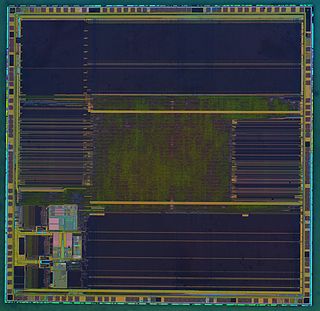
A microcontroller is a small computer on a single metal-oxide-semiconductor (MOS) integrated circuit (IC) chip. A microcontroller contains one or more CPUs along with memory and programmable input/output peripherals. Program memory in the form of ferroelectric RAM, NOR flash or OTP ROM is also often included on chip, as well as a small amount of RAM. Microcontrollers are designed for embedded applications, in contrast to the microprocessors used in personal computers or other general purpose applications consisting of various discrete chips.

The Intel MCS-51 is a single chip microcontroller (MCU) series developed by Intel in 1980 for use in embedded systems. The architect of the Intel MCS-51 instruction set was John H. Wharton. Intel's original versions were popular in the 1980s and early 1990s and enhanced binary compatible derivatives remain popular today. It is an example of a complex instruction set computer, and has separate memory spaces for program instructions and data.

AVR is a family of microcontrollers developed since 1996 by Atmel, acquired by Microchip Technology in 2016. These are modified Harvard architecture 8-bit RISC single-chip microcontrollers. AVR was one of the first microcontroller families to use on-chip flash memory for program storage, as opposed to one-time programmable ROM, EPROM, or EEPROM used by other microcontrollers at the time.

PIC is a family of microcontrollers made by Microchip Technology, derived from the PIC1650 originally developed by General Instrument's Microelectronics Division. The name PIC initially referred to Peripheral Interface Controller, and is currently expanded as Programmable Intelligent Computer. The first parts of the family were available in 1976; by 2013 the company had shipped more than twelve billion individual parts, used in a wide variety of embedded systems.

The MSP430 is a mixed-signal microcontroller family from Texas Instruments, first introduced on 14 February 1992. Built around a 16-bit CPU, the MSP430 is designed for low cost and, specifically, low power consumption embedded applications.

The Zilog Z8 is a microcontroller architecture, originally introduced in 1979, which today also includes the Z8 Encore!, eZ8 Encore!, eZ8 Encore! XP, and eZ8 Encore! MC families.
The C166 family is a 16-bit microcontroller architecture from Infineon in cooperation with STMicroelectronics. It was first released in 1993 and is a controller for measurement and control tasks. It uses the well-established RISC architecture, but features some microcontroller-specific extensions such as bit-addressable memory and an interrupt system optimized for low-latency. When this architecture was introduced the main focus was to replace 8051 controllers.
EFM32 Gecko MCUs are a family of energy-friendly, mixed-signal 32-bit microcontroller integrated circuits from Energy Micro based on ARM Cortex-M CPUs, including the Cortex-M0+, Cortex-M3 and Cortex-M4.

DAVE (Infineon) Digital Application Virtual Engineer (DAVE), a C/C++-language software development and code generation tool for microcontroller applications. DAvE is a standalone system with automatic code generation modules and is suited to develop software drivers for Infineon microcontrollers and aids the developer with automatically created C-level templates and user desired functionalities.
The Infineon XE166 family is a 16-bit microcontroller family, first introduced in 2007. The XE166 can be found in applications like servo drivers, appliance motors, industrial pumps, transportation and power supplies.
The Infineon XC2000 family is a 16-bit microcontroller that can be found in automotive applications including transmissions, hybrid applications, driver assistant systems and engine management.

STM32 is a family of 32-bit microcontroller integrated circuits by STMicroelectronics. The STM32 chips are grouped into related series that are based around the same 32-bit ARM processor core, such as the Cortex-M33F, Cortex-M7F, Cortex-M4F, Cortex-M3, Cortex-M0+, or Cortex-M0. Internally, each microcontroller consists of the processor core, static RAM, flash memory, debugging interface, and various peripherals.
XMC is a family of microcontroller ICs by Infineon. The XMC microcontrollers use the 32-bit RISC ARM processor cores from ARM Holdings, such as Cortex-M4F and Cortex-M0. XMC stands for "cross-market microcontrollers", meaning that this family can cover due to compatibility and configuration options, a wide range in industrial applications. The family supports three essential trends in the industry: It increases the energy efficiency of the systems, supports a variety of communication standards and reduces software complexity in the development of the application's software environment with the parallel released eclipse-based software tool DAVE.

LPC is a family of 32-bit microcontroller integrated circuits by NXP Semiconductors. The LPC chips are grouped into related series that are based around the same 32-bit ARM processor core, such as the Cortex-M4F, Cortex-M3, Cortex-M0+, or Cortex-M0. Internally, each microcontroller consists of the processor core, static RAM memory, flash memory, debugging interface, and various peripherals. The earliest LPC series were based on the Intel 8-bit 80C51 core. As of February 2011, NXP had shipped over one billion ARM processor-based chips.
The Infineon XC2000 family is a 16-bit microcontroller that can be found in automotive applications including transmissions, hybrid applications, driver assistant systems and engine management systems.
RL78 Family is a 16-bit CPU core for embedded microcontrollers of Renesas Electronics introduced in 2010.
AURIX is a 32-bit Infineon microcontroller family, targeting the automotive industry in terms of performance and safety. Its multicore architecture, based on up to three independent 32-bit TriCore CPUs.
C8051 is a microcontroller (MCU) core produced by Silicon Laboratories, Inc. It is based on a patented implementation of the 8051 instruction set architecture.
The MSP432 is a mixed-signal microcontroller family from Texas Instruments. It is based on a 32-bit ARM Cortex-M4F CPU, and extends their 16-bit MSP430 line, with a larger address space for code and data, and faster integer and floating point calculation than the MSP430. Like the MSP430, it has a number of built-in peripheral devices, and is designed for low power requirements.









